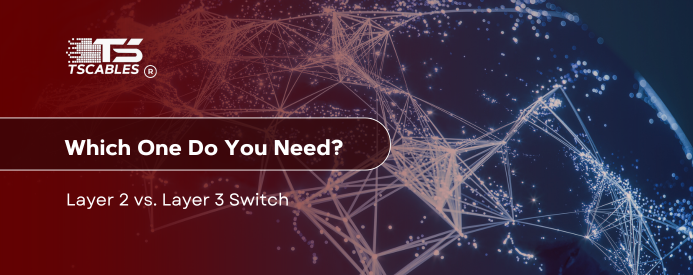Choosing the right network switch can feel like walking a tightrope. One wrong move, and everything tumbles with slow speeds, bad routing, and dropped connections. Whether you’re setting up a small office or managing a large data center, knowing the difference between Layer 2 switches and Layer 3 switches helps keep your network tight and traffic flowing smoothly.
Let’s explain how these layered switches operate, what they’re built to do, and which one suits your setup. You’ll understand Layer 2 vs. Layer 3 switching without needing a tech degree. Let’s break it down into bite-sized bits that just make sense.
What Is a Layer 2 Switch?
A Layer 2 switch works at the data link layer of the OSI model. It moves data based on MAC addresses and is great for fast, local communication. These Layer 2 Ethernet switches keep things quick and clean inside a local area network (LAN). They don’t think too hard; they just move stuff.
Key Functionalities of a Layer 2 Switch
Layer 2 switches handle fast data transfers, isolate network collisions, and support virtual LANs (VLANs). Let’s explore what makes these switches dependable for simple, fast-moving network needs.
High-Speed Forwarding
They send data using MAC addresses, not IPs. That means no extra thinking, just quick decisions and faster movement within the same network.
Collision Domain Isolation
By assigning each port its own domain, they prevent devices from bumping heads. It keeps your network traffic neat, like traffic lanes that don’t merge.
VLAN Support
VLANs let you split one big network into smaller groups. It’s like putting walls in an open office that can ensure it stays organized, private, and efficient.
What Is a Layer 3 Switch?
A Layer 3 switch lives at the network layer. It uses IP addresses to send data between different networks. This switch is part switch, part router. If your network is talking to outsiders or spanning multiple segments, Layer 3 switching has your back.
Key Functionalities of a Layer 3 Switch
Unlike their Layer 2 cousins, these switches can route traffic across networks. Let’s peek into how Layer 3 switches manage advanced routing and broadcast isolation.
Isolated Broadcast Domains
Every port becomes its own island. That means broadcasts stay where they belong, with no network noise spreading where it shouldn’t.
Routing Protocol Support
They speak routing languages like OSPF and RIP. This allows them to guide traffic intelligently across different subnets and external networks.
Policy Routing Support
Traffic rules can be set by more than just IP or MAC. You can route by protocol type, source, or even service. It's like giving your network GPS instructions.
Differences Between Layer 2 and Layer 3 Switches
Layer 2 vs Layer 3 switches can feel similar at a glance, but their features pull them apart. Both switches help move data, but they do it in different ways. One's simple and speedy; the other’s smart and scalable. Let’s compare them across the board.
Address Handling
Layer 2 switches use MAC addresses. Layer 3 switches use IP addresses. It’s the biggest difference, and it affects how data finds its path.
Routing Abilities
Layer 3 switches can make decisions about where to send packets based on IP routes. Layer 2 switches simply move frames within one network.
Cost Difference
Layer 2 switches are generally cheaper and easier to deploy. If you don’t need routing, don’t pay for it. Layer 3 switches cost more, but offer greater control.
Network Size Support
Small networks work well with Layer 2 switching. As your network grows or connects to the outside world, you’ll need Layer 3 switching to keep performance stable.
Setup Complexity
Layer 2 switches are plug-and-play for the most part. Layer 3 switches may require deeper setup, especially for routing rules and protocols.
Final Words
Layer 2 vs. Layer 3 switches is not a matter of which is better, but which fits best. Local networks benefit from Layer 2 switches. Large or segmented networks lean toward Layer 3 switching. Choose based on size, growth plans, and routing needs, and not just specs.
TS Cables helps you make that choice easy. Get reliable Layer 2 and Layer 3 switch solutions that match your network’s real needs, without the guesswork or overkill.
FAQs
What is a Layer 2 switch used for?
It moves data within a LAN using MAC addresses. It’s ideal for quick, local communication.
Can Layer 2 switches handle VLANs?
Yes, they support VLANs to organize traffic into separate virtual networks.
Do Layer 3 switches replace routers?
They can, in some cases, especially inside a large internal network, but not always for internet access.
Which switch is better for large networks?
Layer 3 switches are better for big or multi-segmented networks that need routing.
Is it easy to upgrade from Layer 2 to Layer 3?
Yes, but the setup and cost will increase. It's best done during a network expansion.






